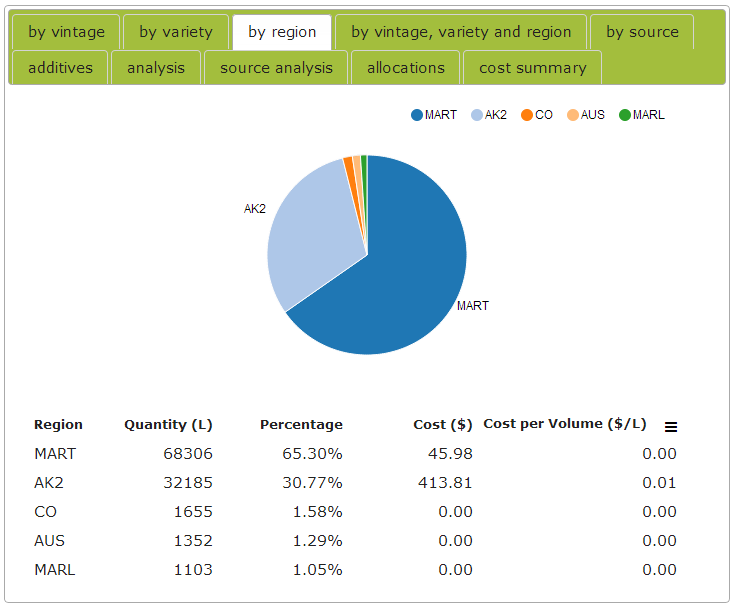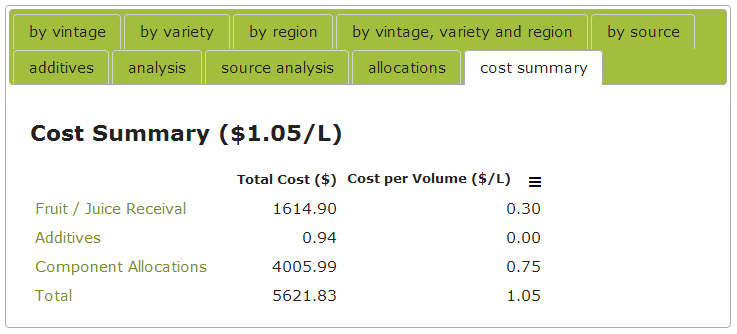Overview
A vessel refers to a tank or vessel that wine is stored in while it is fermenting. The vessels area contains all of the vessels in your winery.
In this document:
Related Terms
Vessel Groups: This is the broadest and most simple differentiation.
Vessel Types: Basically groups vessels that are of a specific type and share the same characteristics, normally by capacity and manufacturing specs eg stainless size and type, or cooper/forest/toast for barrels.
Listing Vessels
You will find the the list of existing vessels by clicking on Vessels in the Make > In the Winery area. You can search for particular vessels by using the search box located next to the ‘New’ button near the top of the screen or the advanced search button directly below that.
Creating Vessels
Required Info
Code, description and type are all required fields. Before you create your first vessel note you must add a new vessel type that this vessel will belong to. You can do this in the Settings > Make > Vessel Types area. See some tips below.
Example Vessel Groups:
| Code | Description | Explanation |
| Oa | Oak | Includes Barriques, half Bq, etc |
| SS | Stainless | These first two entries basically are going to create the difference between tanks and barrels. |
| OF | Open Fermenters | This could show tanks that are generally only used over harvest. Not really necessary if you what to include OFs in with the SS. |
Example Vessel Types:
| Code | Description |
| SMTRMT | Seguin Moreau Troncais Med Toast |
| 8.5kSS | 8500L Stainless Fermenters |
| 8.5kRF | 8500L Red Fermenters |
Default Volume of tanks are set at this level. Oak types, coopers etc are the obvious differences between barrels; Volumes and design would be the obvious differences with tanks. You don’t have to make many differentiations at this level but it is very useful for dealing with barrels. Only showing cooper and forest and not showing year and toast of barrels might be sufficient and even preferable if you include the year of the barrel in the individual vessel code.
Most data, unless strictly required to be numeric, is text. This means that if you have barrel numbers 1 to 200, in the system they will sort like a telephone book, i.e.. the sort order will be 1,11,111….. To avoid this and have more logical lists on reports etc consider renumbering 001,002…..010,011. It is just something to bear in mind.
Importing Vessels
You can import vessels using excel, csv, xml or json formats. This can be useful for initially setting up Vinsight or also if you want to quickly create new vessels eg new barrels that you have purchased for the current harvest.
Click here for detailed instructions on importing data (such as Vessels) into Vinsight.
Viewing Vessels
To view the vessel you will have a ‘View’ option next to each vessel line, this will display the vessel’s details including its code, description, type and current contents.
Vessel Composition (Blend Components)
The composition of any vessel is made up of various component types. Component types include the source of the volume of the wine (such as vintage, variety and region), additives, analyses and costing information. You can view the composition of any particular vessel, broken down in a number of different ways. For example you can view a breakdown by vintage, by variety etc. Simply click on the relevant tab and you will see a pie chart and table detailing the composition of the vessel grouped by that tab’s key.
On the Basic subscriptions or greater, you can also view a cost breakdown of the contents of any particular vessel by clicking on the ‘cost summary’ tab.
Vessel History
To view the history of a particular vessel, view the vessel from the Vessels List, then click on the ‘Vessel History’ tab.
This will bring up a list of the Winery Operations that have been recorded on that vessel.

How do I avoid using a Vessel that is Leaking?
In Vinsight you can “archive” the vessel that is currently unavailable to use, once the Vessel has been fixed you are able to “unarchive” it.
>> Wine Batches

